Abstract
The polysaccharide capsule of Klebsiella pneumoniae is an important virulence factor that confers resistance to phagocytosis. The treatment of encapsulated bacteria with salicylate to inhibit capsule expression was found to enhance the phagocytosis of encapsulated bacteria by human neutrophils only in the presence of cell surface-specific antibodies. Both type-specific rabbit antisera and anticapsular human hyperimmune globulin were employed as opsonins. Salicylate significantly enhanced phagocytosis with homologous, but not heterologous, whole-cell antisera. Antisera, diluted 1:40, no longer opsonized fully encapsulated bacteria but promoted the uptake of multiple salicylate-treated bacteria in > 90% of neutrophils. Salicylate (0.25 to 1.0 mM) also enhanced opsonization with globulin against homologous bacteria. Higher salicylate levels (1 to 2.5 mM) enhanced the opsonization of heterologous serotypes with human globulin. The nature of antibody attachment to encapsulated bacteria was determined by immunofluorescence. Even after the addition of purified capsular polysaccharide to prevent phagocytosis, K-specific antibodies attached in large amounts to bacteria. K-specific antibodies reacted with antigens throughout the capsule and showed a predilection for a denser inner layer of the capsule, indicating that many of the K-specific antibodies may be masked underneath the capsule surface. K-specific antibodies can also be rendered nonfunctional by soluble, cell-free capsular antigen. In culture, large quantities of soluble capsular polysaccharide extrude from bacteria after overnight growth. The reduction in capsule expression caused by salicylate largely affected the soluble, cell-free fraction. Purified capsular polysaccharide was shown to retard the opsonophagocytosis of salicylate-treated bacteria in a concentration-dependent manner. However, extensive washing of encapsulated bacteria to remove loosely attached capsular material did not significantly enhance opsonophagocytosis. In conclusion, cell-free capsule and cell-associated capsule are antiphagocytic; both act to neutralize K-specific antibodies by binding or concealment. Salicylate-mediated inhibition of capsule expression, particularly of the cell-free fraction, improved K-specific opsonization dramatically.
Full text
PDF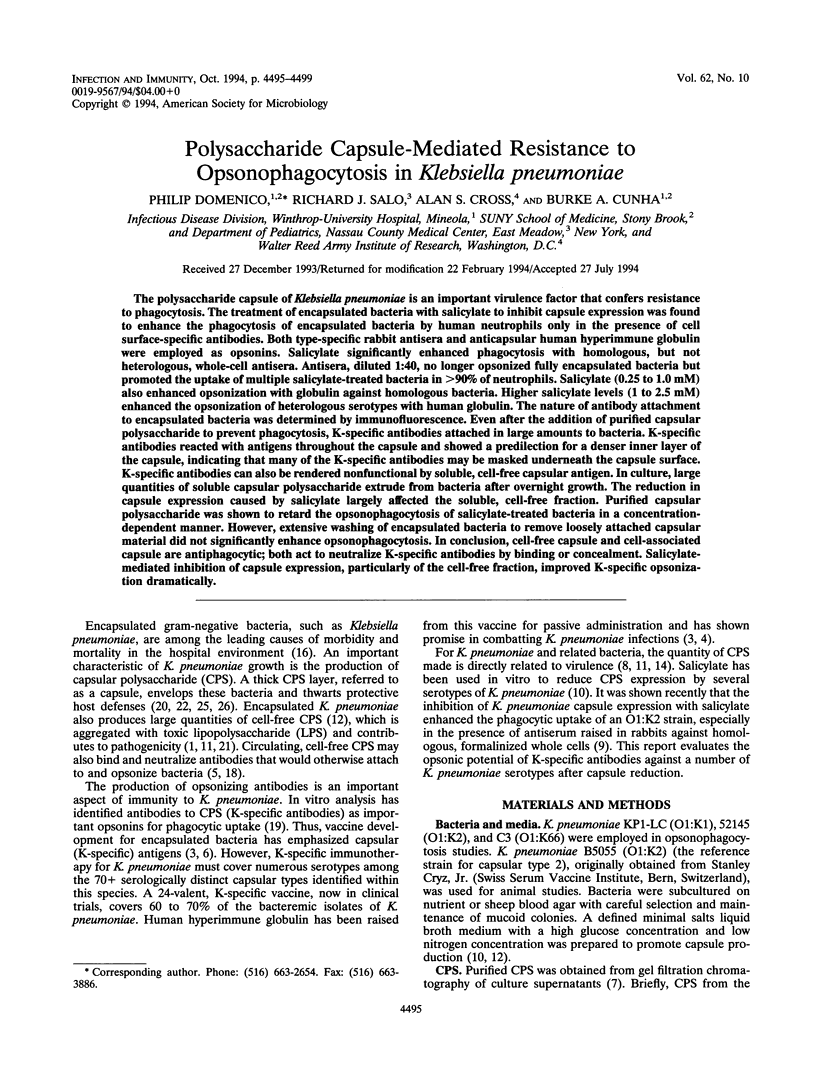
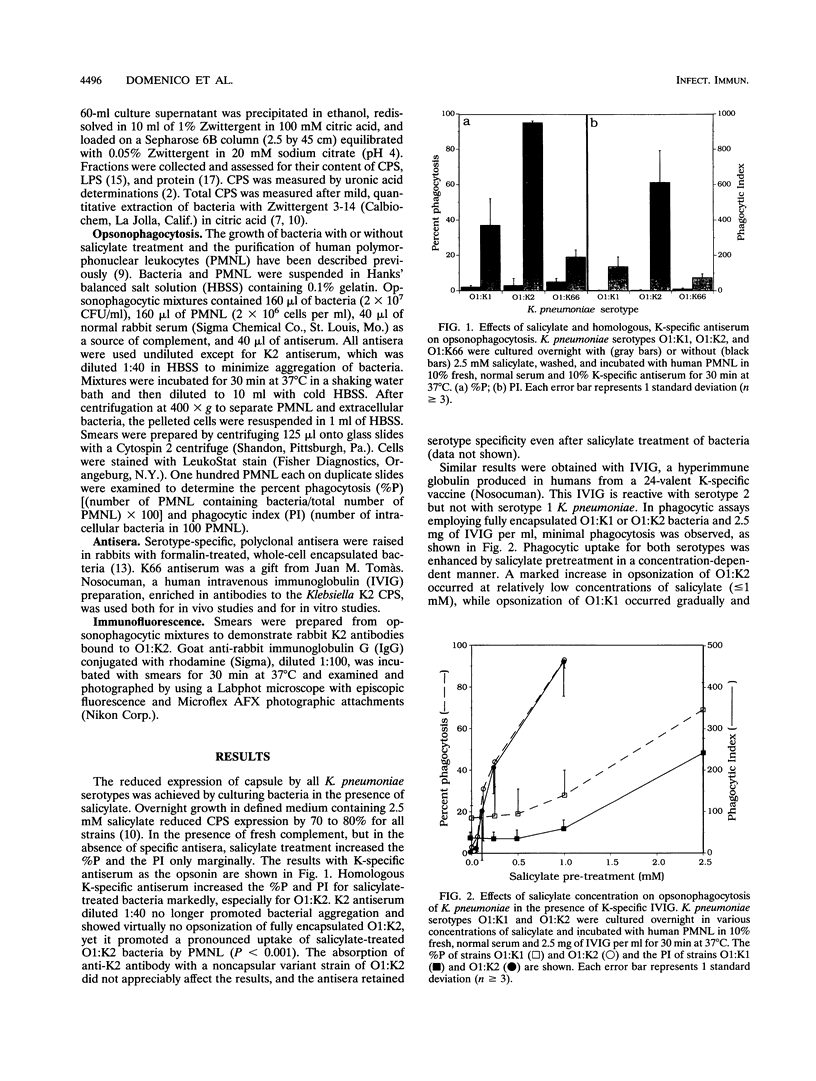
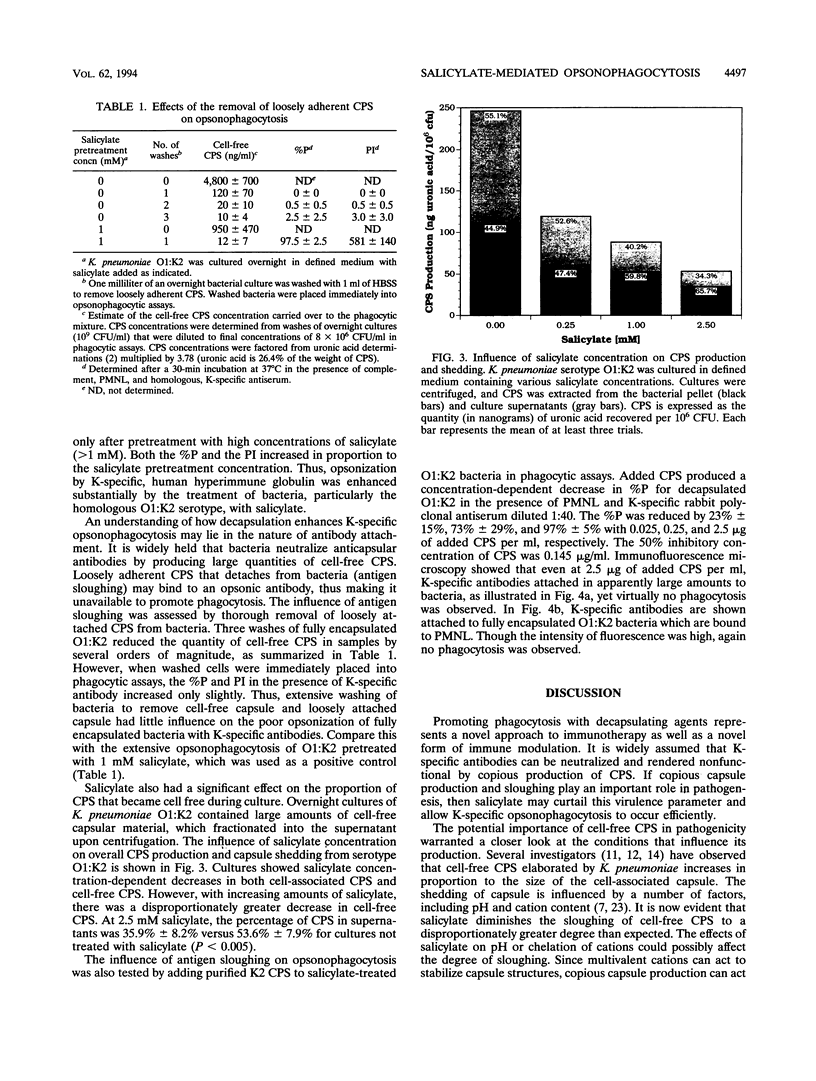
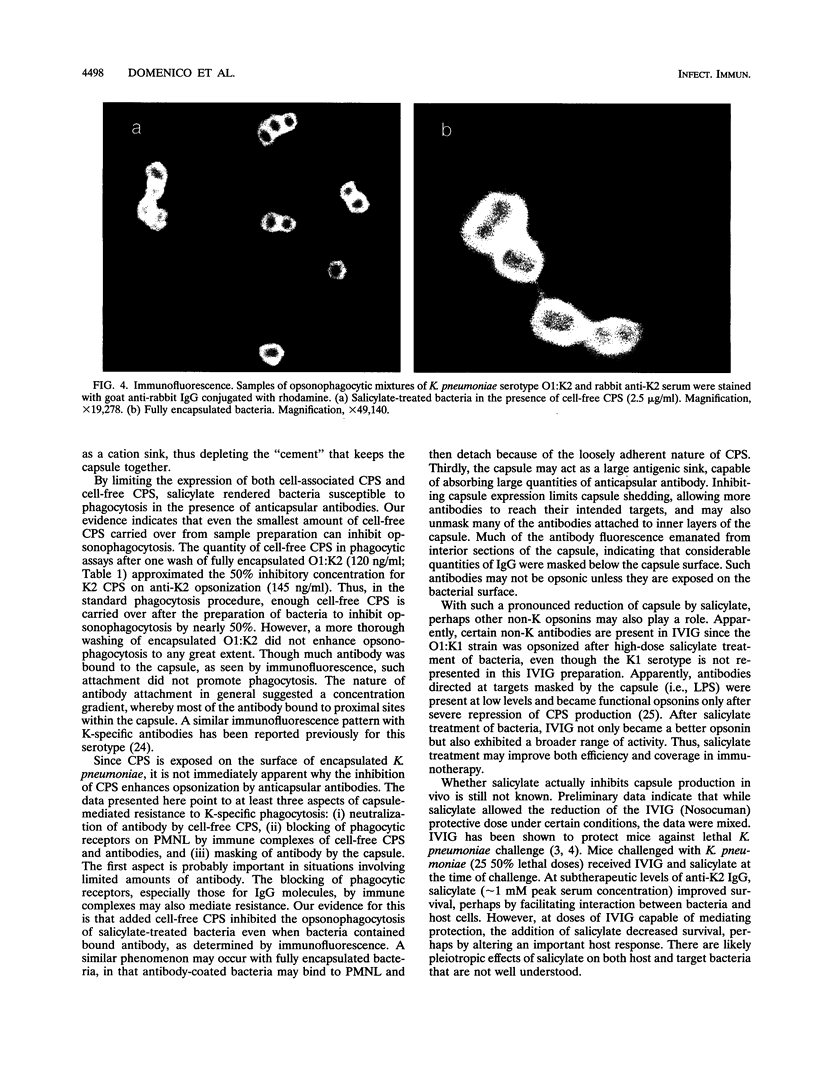
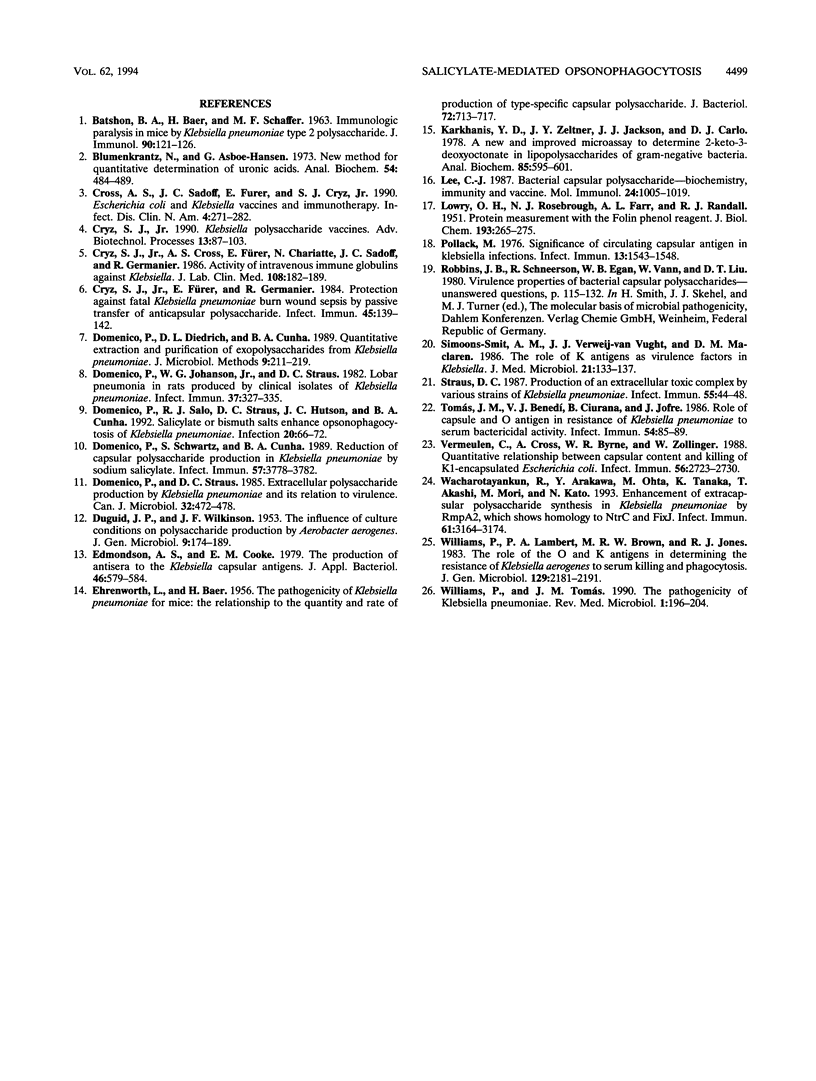
Images in this article
Selected References
These references are in PubMed. This may not be the complete list of references from this article.
- BAER H., EHRENWORTH L. The pathogenicity of Klebsiella pneumoniae for mice: the relationship to the quantity and rate of production of type-specific capsular polysaccharide. J Bacteriol. 1956 Nov;72(5):713–717. doi: 10.1128/jb.72.5.713-717.1956. [DOI] [PMC free article] [PubMed] [Google Scholar]
- BATSHON B. A., BAER H., SHAFFER M. F. Immunologic paralysis produced in mice by Klebsiella pneumoniae type 2 polysaccharide. J Immunol. 1963 Jan;90:121–126. [PubMed] [Google Scholar]
- Blumenkrantz N., Asboe-Hansen G. New method for quantitative determination of uronic acids. Anal Biochem. 1973 Aug;54(2):484–489. doi: 10.1016/0003-2697(73)90377-1. [DOI] [PubMed] [Google Scholar]
- Cross A. S., Sadoff J. C., Furer E., Cryz S. J., Jr Escherichia coli and Klebsiella vaccines and immunotherapy. Infect Dis Clin North Am. 1990 Jun;4(2):271–282. [PubMed] [Google Scholar]
- Cryz S. J., Jr, Cross A. S., Fürer E., Chariatte N., Sadoff J. C., Germanier R. Activity of intravenous immune globulins against Klebsiella. J Lab Clin Med. 1986 Sep;108(3):182–189. [PubMed] [Google Scholar]
- Cryz S. J., Jr, Fürer E., Germanier R. Protection against fatal Klebsiella pneumoniae burn wound sepsis by passive transfer of anticapsular polysaccharide. Infect Immun. 1984 Jul;45(1):139–142. doi: 10.1128/iai.45.1.139-142.1984. [DOI] [PMC free article] [PubMed] [Google Scholar]
- Cryz S. J., Jr Klebsiella polysaccharide vaccines. Adv Biotechnol Processes. 1990;13:87–103. [PubMed] [Google Scholar]
- DUGUID J. P., WILKINSON J. F. The influence of cultural conditions on polysaccharide production by Aerobacter aerogenes. J Gen Microbiol. 1953 Oct;9(2):174–189. doi: 10.1099/00221287-9-2-174. [DOI] [PubMed] [Google Scholar]
- Domenico P., Diedrich D. L., Straus D. C. Extracellular polysaccharide production by Klebsiella pneumoniae and its relationship to virulence. Can J Microbiol. 1985 May;31(5):472–478. doi: 10.1139/m85-088. [DOI] [PubMed] [Google Scholar]
- Domenico P., Johanson W. G., Jr, Straus D. C. Lobar pneumonia in rats produced by clinical isolates of Klebsiella pneumoniae. Infect Immun. 1982 Jul;37(1):327–335. doi: 10.1128/iai.37.1.327-335.1982. [DOI] [PMC free article] [PubMed] [Google Scholar]
- Domenico P., Salo R. J., Straus D. C., Hutson J. C., Cunha B. A. Salicylate or bismuth salts enhance opsonophagocytosis of Klebsiella pneumoniae. Infection. 1992 Mar-Apr;20(2):66–72. doi: 10.1007/BF01711065. [DOI] [PubMed] [Google Scholar]
- Domenico P., Schwartz S., Cunha B. A. Reduction of capsular polysaccharide production in Klebsiella pneumoniae by sodium salicylate. Infect Immun. 1989 Dec;57(12):3778–3782. doi: 10.1128/iai.57.12.3778-3782.1989. [DOI] [PMC free article] [PubMed] [Google Scholar]
- Edmondson A. S., Cooke E. M. The production of antisera to the Klebsiella capsular antigens. J Appl Bacteriol. 1979 Jun;46(3):579–584. doi: 10.1111/j.1365-2672.1979.tb00858.x. [DOI] [PubMed] [Google Scholar]
- Karkhanis Y. D., Zeltner J. Y., Jackson J. J., Carlo D. J. A new and improved microassay to determine 2-keto-3-deoxyoctonate in lipopolysaccharide of Gram-negative bacteria. Anal Biochem. 1978 Apr;85(2):595–601. doi: 10.1016/0003-2697(78)90260-9. [DOI] [PubMed] [Google Scholar]
- LOWRY O. H., ROSEBROUGH N. J., FARR A. L., RANDALL R. J. Protein measurement with the Folin phenol reagent. J Biol Chem. 1951 Nov;193(1):265–275. [PubMed] [Google Scholar]
- Lee C. J. Bacterial capsular polysaccharides--biochemistry, immunity and vaccine. Mol Immunol. 1987 Oct;24(10):1005–1019. doi: 10.1016/0161-5890(87)90067-8. [DOI] [PubMed] [Google Scholar]
- Pollack M. Significance of circulating capsular antigen in Klebsiella infections. Infect Immun. 1976 Jun;13(6):1543–1548. doi: 10.1128/iai.13.6.1543-1548.1976. [DOI] [PMC free article] [PubMed] [Google Scholar]
- Simoons-Smit A. M., Verweij-van Vught A. M., MacLaren D. M. The role of K antigens as virulence factors in Klebsiella. J Med Microbiol. 1986 Mar;21(2):133–137. doi: 10.1099/00222615-21-2-133. [DOI] [PubMed] [Google Scholar]
- Straus D. C. Production of an extracellular toxic complex by various strains of Klebsiella pneumoniae. Infect Immun. 1987 Jan;55(1):44–48. doi: 10.1128/iai.55.1.44-48.1987. [DOI] [PMC free article] [PubMed] [Google Scholar]
- Tomás J. M., Benedí V. J., Ciurana B., Jofre J. Role of capsule and O antigen in resistance of Klebsiella pneumoniae to serum bactericidal activity. Infect Immun. 1986 Oct;54(1):85–89. doi: 10.1128/iai.54.1.85-89.1986. [DOI] [PMC free article] [PubMed] [Google Scholar]
- Vermeulen C., Cross A., Byrne W. R., Zollinger W. Quantitative relationship between capsular content and killing of K1-encapsulated Escherichia coli. Infect Immun. 1988 Oct;56(10):2723–2730. doi: 10.1128/iai.56.10.2723-2730.1988. [DOI] [PMC free article] [PubMed] [Google Scholar]
- Wacharotayankun R., Arakawa Y., Ohta M., Tanaka K., Akashi T., Mori M., Kato N. Enhancement of extracapsular polysaccharide synthesis in Klebsiella pneumoniae by RmpA2, which shows homology to NtrC and FixJ. Infect Immun. 1993 Aug;61(8):3164–3174. doi: 10.1128/iai.61.8.3164-3174.1993. [DOI] [PMC free article] [PubMed] [Google Scholar]
- Williams P., Lambert P. A., Brown M. R., Jones R. J. The role of the O and K antigens in determining the resistance of Klebsiella aerogenes to serum killing and phagocytosis. J Gen Microbiol. 1983 Jul;129(7):2181–2191. doi: 10.1099/00221287-129-7-2181. [DOI] [PubMed] [Google Scholar]



